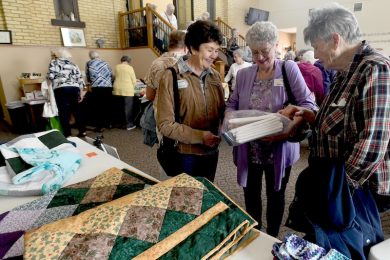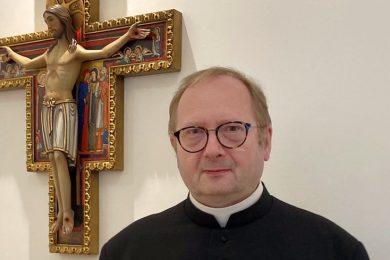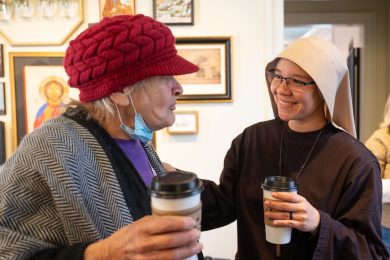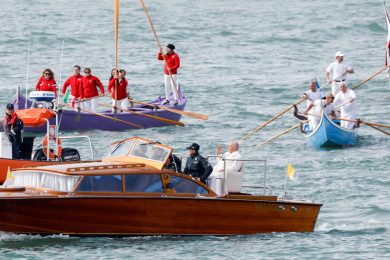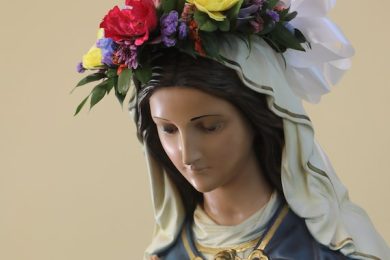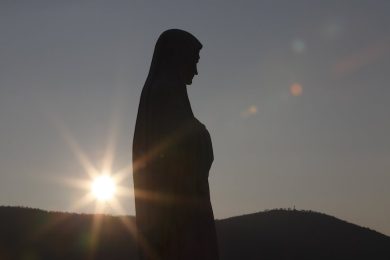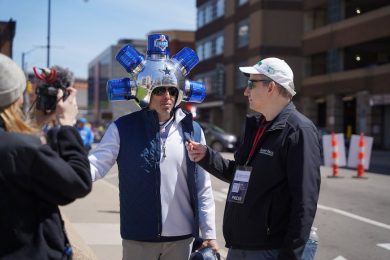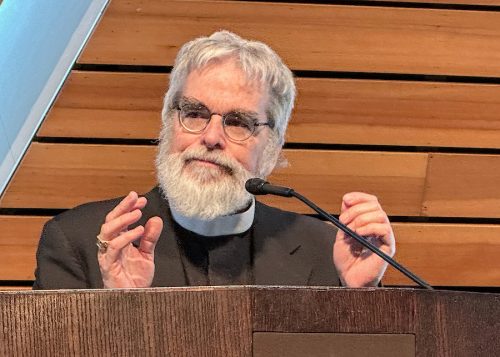By Barb Umberger
“It’s human to look at the stars and to realize that there’s more to life than what’s for lunch,” said Jesuit Brother Guy Consolmagno, director of the Vatican Observatory. “The very thing that makes us different from a clever cat, the very thing that makes us breathe out, ‘oh my God’ — that’s the human soul, the image and likeness of God,” he said.
“And so, every morning, I look forward to going back to the lab, dropping meteorites into liquid nitrogen, finding out how each new number falls in the plot of the data. It’s slow and it’s tedious and it’s fun as all get out,” he said. “I mean, meteorites, right? You can touch pieces of outer space — and liquid nitrogen. What’s more fun than that?”
Brother Consolmagno spoke to a nearly full house April 17 at the McNamara Alumni Center on the Minneapolis campus of the University of Minnesota. He titled his remarks, “Captured by the Stars: Why Do We Look Up to the Heavens?”
The event was hosted by Anselm House, a center for Christian studies that helps students and faculty at the University of Minnesota (Twin Cities) connect Christian faith and knowledge with all of life, said Casie Szalapski, its program manager.
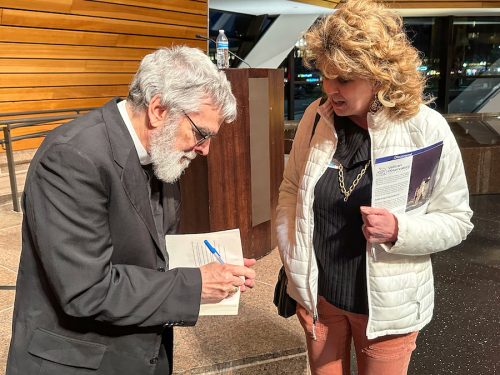
Anselm House sponsors an annual Anderson Lecture in science and religion, inviting “scientists who are very well respected in their field but who are also Christians and have thought deeply about how their faith speaks to their work,” said Szalapski. “My colleague, and the director of Anselm House’s Center for Faith and Learning, AJ Poelarends, is an astrophysicist and he was familiar with Brother Guy’s work and suggested we extend the invitation,” she said.
Science only happens because of the “oh, my God moments,” Brother Consolmagno said. “Science needs ‘oh my God.’ Nothing would happen without it. And that’s why we will get support from the Church, from a pope who himself was a chemist. I mean, look, he showed up in my lab wearing a white lab coat,” he said to laughter from the crowd as he projected a photo of Pope Francis in his white vestment.
That’s why it’s important to remember that creation happened over seven days, Brother Consolmagno said. “The first six, day by day by day, all the physical pieces were put together, but the climax of the story of creation is the Sabbath, where we spend the time to admire what God has done.
“And if you lose that, then you’ve lost the reason for why you’re doing the science,” he said.
Brother Consolmagno, who has special expertise in planetary science, specifically asteroids and meteorites, received the Carl Sagan Medal in 2014 for outstanding communication from the American Astronomical Society’s Division for Planetary Sciences.
He received his bachelor’s and master’s of science degrees in earth and planetary sciences from the Massachusetts Institute of Technology and his doctorate in planetary science from the University of Arizona. He started his undergraduate studies at Boston College but said he “didn’t fit in the dorms very well.”
“They’re guys who just wanted to party, and I was a nerd,” he said.
His best friend from high school went to MIT, which he called “a big nerd school, full of nerds, just like me.” And it offered weekend movies and pinball machines “and tunnels you could explore at night, and the world’s largest collection of science fiction books.”
“I figured if I’m going to be a nerd, I ought to go to nerd school,” Brother Consolmagno said. But he also recognized MIT was where he “could stoke his passion.”
He served in the Peace Corps for two years in Kenya teaching physics and astronomy, then taught physics in the U.S. before entering the Society of Jesus in 1989. He started his work at the Vatican Observatory in 1993. His responsibilities at the observatory, which is based in Castel Gandolfo, Italy,include serving as curator of the Vatican meteorite collection. The Vatican also has a telescope on Mount Graham in southeastern Arizona.
During the presentation, Brother Consolmagno explained his work, including experiments with meteorites, which he described animatedly. It ended with time for questions and answers.
A reception with Brother Consolmagno followed across the street in the new office of Anselm House. He also gave a presentation April 16 at the University of St. Thomas in St. Paul.
Asked after his presentation how his research impacts his faith, Brother Consolmagno said it gives him joy. “I feel like the universe is a giant puzzle, a giant game where God gets to play with me,” he said. “I’m reminded of when I was a little kid and my mom would play cards with me and it was her way of telling me she loved me, and the universe is God’s way of telling me he loves me.”
Brother Consolmagno said he gets “this little burst of joy every time I see something,” followed by “almost a chuckle of, ‘oh, wasn’t that wonderful? Let me show you the next one.’ So it (research) is really an act of prayer because it’s a place where I encounter God,” he said.
When asked for messages to the faithful on the topic of science and the Church, Brother Consolmagno responded, “Science was invented by the Church” and it is “our way of trying to understand God.”
“It is not an absolute set of facts, but it’s an approach,” he said. “And we should never think that we know it all, but we should never be afraid of it.” He recalled St. John Paul II saying “truth does not contradict truth.”
Don’t be afraid, but don’t think that one bit of science is going to overthrow everything, because our science isn’t perfect,” Brother Consolmagno said. “Our faith, our understanding of the faith, isn’t perfect. In both cases, it’s a relationship of love.
“And you never tell somebody you love, ‘Oh, I understand you perfectly now.’ . . . We don’t understand the universe perfectly, but we never stop trying. We never understand God perfectly, but we never stop trying. And we’re never afraid to learn new things about the ones we love.”
A recording of the April 17 presentation is available for viewing at the Anselm House YouTube channel.
Barb Umberger is a staff reporter for The Catholic Spirit, the newspaper of the Archdiocese of St. Paul and Minneapolis.

